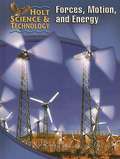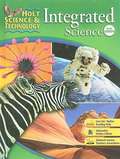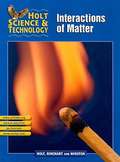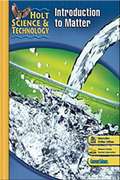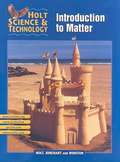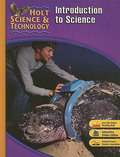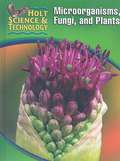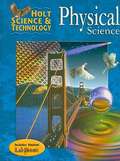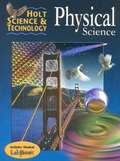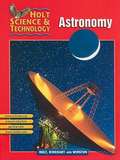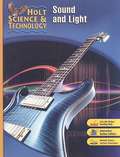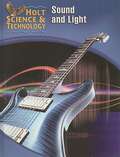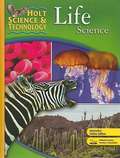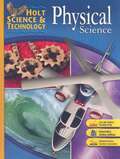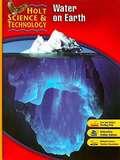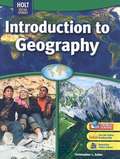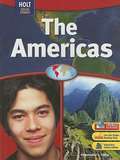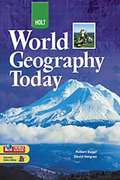- Table View
- List View
Holt Science and Technology: Forces, Motion, and Energy
by Leila Dumas William G. LambAmong the topics covered in this book are: matter in motion, forces and motion, forces in fluids, work and machines, energy and energy resources, heat and heat technology.
Holt Science and Technology: Inside the Restless Earth
by Holt Rinehart WinstonScience is a process of discovery, a trek into the unknown. The skills you develop using Holt Science & Technology--such as observing, explaining observations and ideas--are the skill you will need for the future. There is a universe of exploration and discovery awaiting those who accept the challenges of science.
Holt Science and Technology: Integrated Science, Level Green
by Holt Rinehart WinstonNIMAC-sourced textbook
Holt Science and Technology: Interactions of Matter
by Holt Rinehart WinstonThis book was created to make your science experience interesting, exciting, and fun!
Holt Science and Technology: Introduction to Matter
by Holt Rinehart WinstonThe contents of "Holt Science and Technology: Introduction to Matter" are: The Properties of Matter, States of Matter, Elements, Compounds, and Mixtures, Introduction to Atoms, and The Periodic Table.
Holt Science and Technology: Introduction to Matter
by Holt Rinehart WinstonThis book was created to make your science experience interesting, exciting, and fun!
Holt Science and Technology: Introduction to Matter
by Mapi Cuevas Sally Ann VonderbrinkSome of the tools in this book to help one become better in Science and Technology are reading warm-up, reading strategy, internet connect boxes, illustrations and photos, section reviews and study tips.
Holt Science and Technology: Introduction to Science
by Holt Rinehart WinstonExploring, inventing, and investigating are essential to the study of science. However, these activities can also be dangerous. To make sure that your experiments and explorations are safe, you must be aware of a variety of safety guidelines. You have probably heard of the saying, "It is better to be safe than sorry."
Holt Science and Technology: Life Science
by Holt Rinehart WinstonLife science is the study of living things-from the tiniest bacterium to the largest tree! In this unit, you will discover the similarities of all living things. You will learn about the tools life scientists use, and you'll learn to ask your own questions about the living world around you.
Holt Science and Technology: Microorganisms, Fungi and Plants
by Holt Rinehart WinstonScience textbook.
Holt Science and Technology: Microorganisms, Fungi and Plants
by Holt Rinehart WinstonSome topics broadly covered in this book include: bacteria & viruses, protists & fungi and plants.
Holt Science and Technology: Physical Science
by Holt Rinehart WinstonIt is interesting to learn how scientific information is being used in the really world. You can see for yourself in the Apply features. You will also be asked to apply your own knowledge. This is a good way to learn!
Holt Science and Technology: Physical Science (California Edition)
by Holt Rinehart WinstonThis book contains unit lessons on: Introduction to Matter, Motion and Forces, Work, Machines, and Energy, The Atom, Interactions of Matter, Introduction to Astronomy, etc.
Holt Science and Technology: Short Course J
by Holt Rinehart WinstonThis book was created to make your science experience interesting, exciting, and fun!
Holt Science and Technology: Sound and Light
by Holt Rinehart WinstonThis textbook contains topics on The Energy of Waves, The Nature of Sound, The Nature of Light, Light and Our World. Also contains a host of other features such as Labs and Activities, etc.
Holt Science and Technology: Sound and Light
by Holt Rinehart WinstonA book on sound and light, which covers the following topics: nature of sound & light, energy of waves and light & our world.
Holt Science and Technology: Student Edition Life Science 2007
by Holt Winston RinehartScience Textbook
Holt Science and Technology: Student Edition Physical Science 2007
by Rinehart And Winston Holt BorgfordPhysical Science Grade 3
Holt Science and Technology: Water on Earth
by Robert J. Sager Kathleen KaskaThis textbook describes the water on Earth, in all its various forms.
Holt Social Studies: Introduction to Geography
by Christopher L. SalterHolt Social Studies: Introduction to Geography is a ticket to the exciting world of geography.
Holt Social Studies: The Americas
by Christopher L. SalterTo study the world, geographers use a pattern of imaginary lines that circles the globe in east-west and north-south directions. It is called a grid. The intersection of these imaginary lines helps us find places on Earth.
Holt World Geography Today
by Robert J. Sager David M. HelgrenThis geography textbook helps students make connections between what they learn in class and real events around the world today.
Holt World Geography Today (Texas Edition)
by Robert J. Sager David M. HelgrenDo you know why the loss of huge forest areas in one part of the world can affect areas far away? Why does the United States have many different kinds of churches and other places of worship? Perhaps you are curious why Americans and people from other countries have such different points of view on many issues. The key to understanding questions and issues like these lies in the study of geography.
